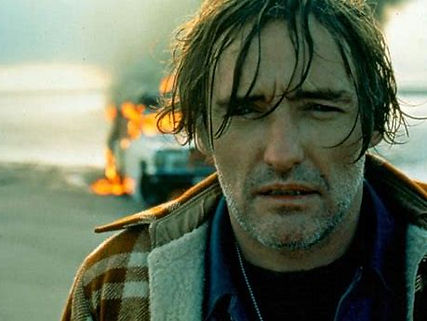Out of the Blue
It wasn't just a strange night. It was a Dennis Hopper night.
by Christopher Dow
The evening started innocently enough in the Media Center at Rice University in Houston. But now, here we were, on the outskirts of town, at the Big H Speedway, where hurtling steel and engine thunder split the air with the thrill of spinout and victory.
We weren’t here to watch the race, though. We were here to watch Dennis Hopper blow himself up.
As the half-dozen school busses we rode in pulled to a stop in a vacant area on the periphery of the speedway, the final race of the night was winding down. Some pretty ugly vehicles lurched and slid around that dinky oval track. The raw clay surface was packed to the density of stone and slicked by grease and damp night air, and the cars looked like go-carts on steroids instead of something you’d see at Le Mans.
While the drivers clashed and jostled for final position, the announcer’s amplified voice, nasal and filled with bored indulgence, hung limply in the oily air. “Stick around after the race, folks,” he intoned. “Watch a famous Hollywood film personality perform the Russian Dynamite Death Chair Act. That’s right, folks, he’ll sit in a chair with six sticks of dynamite and light the fuse. Will the flagman please come out and flag him as he comes down?”
It was April 1983, and Hopper had come to the Media Center to screen his movie Out of the Blue (1980) and deliver a lecture. The film, a classic of nihilism, portrayed the ultimate dysfunctional family. The father, played by Hopper, is an ex-biker turned truck driver who crashes into a school bus, killing all the children aboard, and the mother is a junkie. And there is a subtext of incest. No wonder their daughter, a seminal punker in a huge leather jacket, finds it difficult to cope. The film’s culmination was death in an exploding school bus. It wasn’t a bad film, but it was grim.

Hopper’s “lecture” wasn’t particularly grim, but it certainly was dysfunctional. He was too drunk and stoned to stand in front of us, so he stayed in the projection booth and rambled on over the PA system for twenty or thirty bizarre minutes. I couldn’t tell you what he talked about; I’m not sure he really talked about anything. The one thing that did register, however, was that he wanted to blow himself up in the parking lot of Rice Stadium.
As it turned out, Houston fire marshals wouldn’t let him set off the explosion in the city, so Hopper had to take us outside the city limits where he would be allowed to detonate in peace.
That’s Dennis Hopper for you—always pushed to the limits.
Someone rented enough school busses to haul the whole crowd and sent us off to the Big H, on Houston’s north side, to watch the explosion. The motif of explosions and school busses remained consistent enough between film and reality that some of us may even have felt a touch of paranoia as we boarded.
At Big H, we waited, and at last Hopper stepped onto the track. He’d been with us all evening, yet it was the first time most of us had seen him.
He seems taller in real life.
Behind him a stunt coordinator and accomplices set up the Russian Dynamite Death Chair. It looked like just a big cardboard box covered with aluminum foil, but six sticks of dynamite make one heck of a whoopee cushion. At last it was ready, and Hopper and his stunt coordinator approached. The coordinator talked to Hopper, gestured to the chair, talked some more, then moved off.
Way off.
Hopper crouched on the chair. The police pressed the rapt crowd back. Hopper lit a match, and the breezy air went silent with expectation.
The wind blew out the match.
He lit another, and it, too, went out. And another.
It didn’t take much imagination to hear him cursing the damp, brisk air and cruddy matches. He struck the whole pack all at once.
That did the trick. The sparked fuse sizzled for a moment then abruptly blossomed into a brilliant flash. We were all slapped by an invisible hand, yelled at thunderously.
Dennis Hopper, at one with the shock wave, spasmed headlong in a halo of fire. For a single, timeless instant he looked like Wile E. Coyote, frazzled and splayed by his own petard.
Then billowing smoke hid the scene.
We all rushed forward, past the police, into the expanding cloud of smoke, excited, apprehensive, and no less expectant than we’d been before the blast. Were we looking for Hopper or pieces we could take home as souvenirs?
Later Hopper would say blowing himself up was one of the craziest things he’d ever done and that it was weeks before he could hear again. At the moment, though, none of that mattered. He had been through the thunder, the light, and the heat, and he was still in one piece.
And when he staggered out of that cloud of smoke, his eyes were glazed with the thrill of spinout and victory.
This article originally appeared in the fall 1995 issue of Sallyport: The Magazine of Rice University. When Dennis Hopper learned about the article, he had his agent contact me. Though Hopper had referred to the incident several times in interviews over the years, the article was, the agent said, the only eyewitness account. Hopper wanted some extra copies, so I sent him something like fifteen or twenty.





